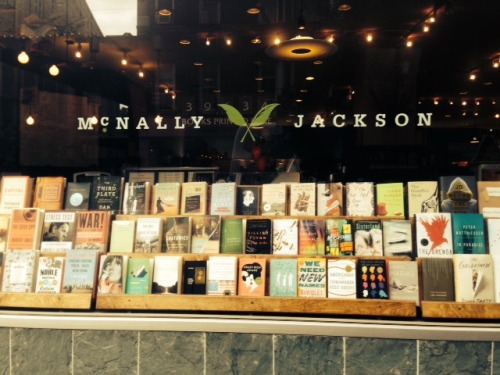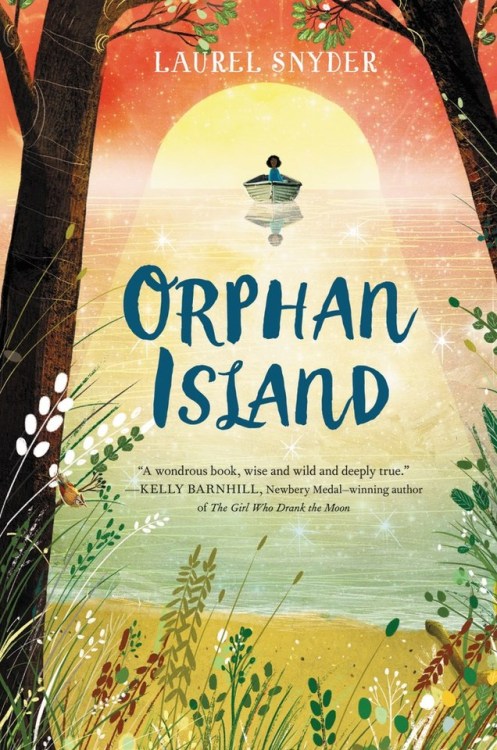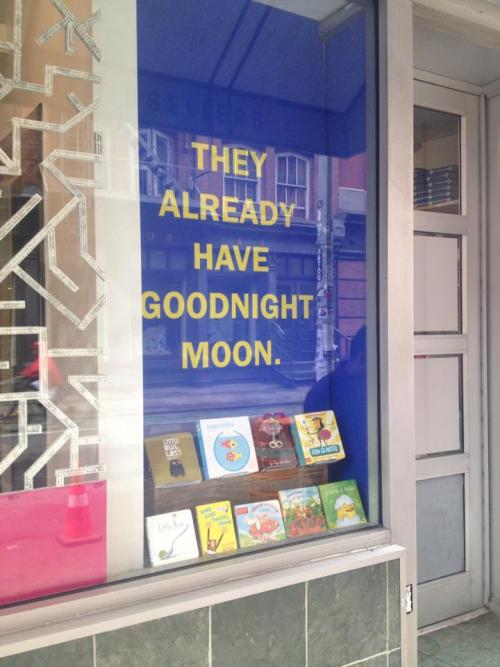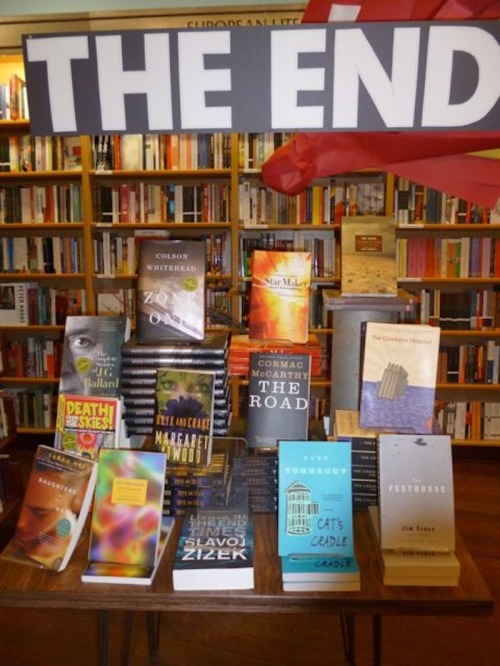#mcnally jackson
I waited to begin Orphan Island until I knew I could spend the whole day with it, because I suspected once I dove in I wasn’t going to surface until the last page–and I was right. But days later I find myself drifting back to the island and its denizens again and again. Orphan Island is that kind of place and that kind of book. The kid in me was carried away by the wildness and mystery and adventure even as the parent in me ached with the bittersweet and sometimes brutal truths underpinning it all. -Kate Milford, McJ kids’ bookseller and Edgar award-winning author of Greenglass House.
Post link
McNally Jackson is delighted to be hosting @juliebuxbaum tomorrow for a celebration of her new novel Tell Me Three Things, discussed below by our Teen Reviewer, Lilian.
—–

There are many challenges you have to face when you enter a new school, especially when it comes to High School. Imagine being forced to transfer in the middle of your school years, leaving all your friends and home, then flying off to a new land. Julie Buxbaum seems to be able to make that hardship become reality in Tell Me Three Things. She mixes loss with love and more genres in her new story.
Jessie Holmes is a sixteen year old nothing when she enters her new high school in Los Angeles, California only two years after her mother’s death. Everything seems to go wrong, her stepmother’s house is nothing like her home in Chicago. Her best friend is left behind, and she is forced into a new life with a stranger that her father met online. That is, until she receives an email from an anonymous who goes by Somebody Nobody (SN). Claiming to know her without her knowing him, SN and Jessie form an online friendship that suddenly makes her desperate to meet this person. While Jessie goes through her junior year creating new friendships, facing bullies, and eventually developing a crush, SN seems to become a big part of her newly formed life, even if it is only on I Messages on her phone. Jessie spends her school months asking the same question over and over again. Who is Somebody Nobody?
Jessie seems to be like many other simple teenage girls. Trying to get passed High School so they can finally leave to go to College. But there will be many obstacles along the way that eventually will be hard to overcome. Though there will always be someone that will have your back, someone that you could go to for advice. If not someone, then maybe something. “What if the person you need the most is someone you never met.” There can be so many people who are willing to help you go through your tough times, but it is important to find the people you can trust entirely to share your deepest secrets. And maybe, you can find friends in the most odd way, just like Jessie and SN.
Julie Buxbaum writes Tell Me Three Things in the most detailed way possible, making me flip through the pages without stopping. She shares all the different emotions that can be felt during High School and explains the true meaning of friendship. This would definitely be a book for readers who love tragedy and friendship/ romance. Just like that, you’ll be reading so much that you’d be done in a day. -Lilian R., Age 14
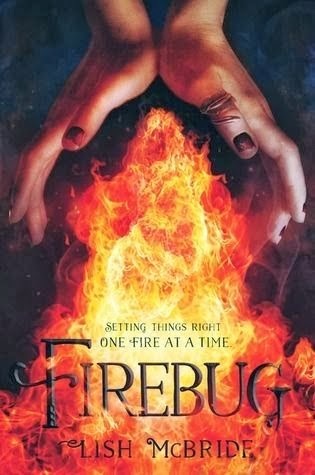
In our world, our country is run by the president who keeps the government in order. We have laws to protect us from the bad and help us live through tough times. However, not every world has that.
Firebug is an adventurous mystery. Wherever there’s an end, a new beginning/problem starts. Firebug focuses on a young teenage girl, Ava, who has the ability to start a fire just by thinking about it. Though it’s not always a gift. Ava is controlled by the Coterie. A secret agency which is run by a vicious, power hungry vampire, Venus. The Coterie collects all different types of people like Ava. They don’t necessarily have to be fire powered, they can be something else like turning into a creature or communicating with nature. Then they force these people to work for them, and there’s no way out. With the death of her mother being one of her many problems, Ava lives with her closest father friend, Cade, and her two best friends. They also are in the Coterie. Ava always knew the Coterie was bad and has dreamed of an exit, out of their world and into hers, every single night. Though it was not until now, she realized that if she lets the Coterie keep ruling, everyone would be dead. Throughout the book, many people she knows and loves turn out to be someone the opposite of what she expected them to be. And the closer she comes to the truth, the more she realizes that she has to get rid of what was never meant to exist.
Things can start off to be perfectly okay with your life, then all of a sudden it turns upside down. Many books have that aspect, but this one specifically focuses on the fact that you shouldn’t allow someone to control you, because if you do, the more you’ll be hurting yourself to try to live so they’ll accept you without hurting you. That was Ava’s mistake, even thought she couldn’t say no, there was always the slightest chance that she could.
I give this book 4 out of 5 stars. The details were amazing and you could really live in Ava’s world. It had amazing heroines, villains, like any other fantasy. However, the beginning for me was kind of slow and it took me a while to really get into it. Though the more I did, the more things started to happen. Pacing happens the same way in many mysteries I have read. It begins slower because the characters are being introduced and then the action begins. You wouldn’t understand the action if you didn’t know who was making it.
-Lilian R. Age 13
I can’t remember when I first read The Westing Game. We had a copy in our car when I was a kid, along with a copy of Fantastic Mr. Fox and probably a few other books I can’t remember. But those two in particular my sister and I quite literally read to pieces. I don’t remember which edition I had, though. I did an image search just now and there were three or so that it might have been.
This one?
This one?
This one, maybe?
I think it’s the first one, but I really don’t remember, which is maybe odd considering I read that book—or part of it—basically every month for a period of years.
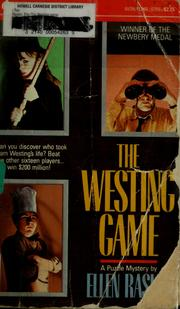
My family used to love to take road trips. On any halfway-decent weekend day, my parents would pack us all in the minivan and we’d head out into the wilds of Maryland. There was a TV and VCR in the van and sometimes we’d watch movies or shows, but often we—or at least my sister and I, who were the oldest—would read. We’d half-watch the world pass out the windows in between chapters as we drove from flea markets to antique shops to interesting beaches where we’d wait for ferries to Eastern Shore fishing villages where my parents knew you could get good crabcakes.
I read The Westing Game constantly on these drives, leaving it in the car to pick up again the following weekend on the next drive. I read it over and over, to the point where when I read it now, I half expect to look up from the page and see the road to Solomon’s Island rushing past out the window of our old minivan. These memories even have their own soundtrack, which is mostly the soundtrack from The Muppet Movie interspersed with musical numbers from Newsies and the All New Mickey Mouse Club circa about 1990, plus or minus a couple years. The Westing Game was also one of the first ten or so books I read to my son after he was born, when he would still lie quietly and let me read him anything I wanted. (Curse you for having opinions now, kid. I can only read Maybelle the Cable Car so many times before it goes mysteriously missing.)
The copy I read him—the one I read a couple times a year for much of my adult life—is the Puffin Modern Classics edition, the one with the note from Ellen Raskin’s editor, Ann Durrell. I read it out of nostalgia and love for the story, but also because it’s come to mean something more to me now than it did twenty-odd years ago.
Ms. Durrell says in her editor’s note that Ellen Raskin made The Westing Game up as she went along. This was a revelation to me—that anyone could craft so intricate a story, so insoluble a puzzle, on the fly. I commented on this once, several years ago, on Twitter, and a number of people spoke up and argued that this was probably an
apocryphal anecdote. But I believe her editor, especially since I’ve also listened to the audio recording that’s part of the Raskin archive at the Cooperative Children’s Book Center, where Ellen Raskin herself confirms it. Right around the 17:45 mark, she says that she doesn’t outline—that working from an outline would make the process “too boring,” and that she doesn’t know what’s going to happen and doesn’t know the answer before she comes to it. “It’s just deadly,” she says. “You have to give your characters the freedom to tell you what’s going to happen next.” Ann Durrell, who had also edited her earlier books, asked her to submit 50 pages of Raskin’s new story, and based on that, she got her contract for The Westing Game. This isn’t to say that she didn’t research (she did, a lot) or that she didn’t revise (she did, also a lot). There’s a treasure trove of information, drafts and notes at the website of the CCBC, and if you click through, you can follow the progress of the book from those first pages to finished manuscript. A lot of work went into it—it was two years before Ellen Raskin would finish the book she’d sold based on those initial fifty chapters.
To me, that process is utterly beautiful; especially the faith that Raskin had in her stories, her characters, and herself, and the faith her editor had in them, too. At times when I need help believing in my ability to make a story come together, I crack open The Westing Game. I also hate to outline, and though I may never write so elegant a puzzle, I take comfort in knowing that one of the most important books of my childhood was written exactly the way I like to work, and that it was neither an easy nor a quick process.
Other times I crack The Westing Game open because I know when I do, I’ll feel late-spring sun on my face, filtered through the tinted window of a Chevy Astro. I’ll hear the babble of two parents, two brothers, my sister, maybe even my best friend Alli, and somewhere under all the voices, the sweet, sweet stylings of Tony Lucca singing “Take Time.” But only for a minute, because after about a page I’m swept back to Wisconsin, pedaling alongside Turtle Wexler, both of us with braids like kite-tails flying behind us as we rush to tell everyone in Sunset Towers that there’s smoke coming from the chimney of the Westing House. Strange!
Kate Milford is a bookseller at McNally Jackson Books and the author of several novels for young readers. Her most recent book, Greenglass House, was nominated for an Edgar Award, a Nebula Award, and The National Book Award. She’s the real deal.
Ted Sanders’ The Keepers: The Box & the Dragonfly is on sale today! Our excellent teen reviewer Lilian took a look at the novel for us:
—–

The Keepers is an exciting novel written by Ted Sanders, the author of ‘No Animals We Could Name’ and many other well written stories. Starting now is the first book in the series 'The Keepers. The Box and The Dragonfly’. You find yourself living inside a world with evil giants, strange creatures, and magical objects that only you can posses,.
This book follows Horace Andrews, a twelve year old boy who seems to understand the world until he sees something - one thing, his own name written on a single sign. His confusion leads him to an underground place called “The House of Answers”. Anyone who walks into this place has to choose wisely. An object with a special ability that he/she feels the right to own carefully. It could be kept in this person’s hands for years, a few months, or even a few minutes. All these objects are called “Tanu”. Once fallen into the right hands they become this person’s “Tanji”. Horace feels a strange draw to a golden box, and after many experiments realizes it’s power - time travel. He soon possesses the power to look into the future. Danger awaits though, as groups of gigantic ten feet men go after all the Tanji trying to keep the magic to themselves. Horace does whatever he can to protect the box, and soon pairs up with another young Keeper; Chloe, a twelve year old girl who is able to walk through walls, which comes from her Tanji, a necklace with a silver dragonfly attached to it. They form a strange friendship bond walking in and out of danger, almost in the hands of the men who are after their Tanji and even the Keepers themselves.
The Keepers is a book for all ages 10+. I would highly recommend it to anyone who loves adventurous mysteries. If you do, you’ll get absorbed by this story after the first two chapters. It’s medium-paced, though there’s always something to look forward to after each chapter. You never know what’s going to happen next. The gripping story also shows that a simple mistake could lead to a total disaster. This is only the beginning to the many adventures of Horace and Chloe. I give this book 4.5 stars out of 5.
-Lilian R, 13
See you Wednesday for Cynthia Weil! I’m Glad I Did will get you right on through your Mad Men withdrawal, we promise.
SoHo Teen in SoHo! See what I did there?
Fine, the store is really in Nolita, but whatever. It was worth it. See you Wednesday!
Post link
Thursday, 12/4, 7pm: Throw on your ugliest holiday sweater and come to McNally Jackson’s reception for the exceptional story collection My True Love Gave To Me, featuring ten of the authors. Oh, and cookies.
Post link
Welcome to 52 Fear Street, McNally Jackson’s month-long celebration of R.L. Stine. Join us TONIGHT, October 30th, for an evening with Mr. Stine himself and his Fear Street editor Kat Brzozowski, and follow the #52FearSt tags on tumblr and Twitter to hear what authors, booksellers, and editors have to say about Fear Street and Goosebumps.
Today’s post is from McNally Jackson bookseller Matt, who has been recently and thoroughly possessed by the soul of Gertrude Stein, that lucky duck.
Stein on Stine: A Camera Is Not A Camera Is Not A Camera Is Not A Camera
The thing about R.L. Stine is there is always a thing, a scary thing, and it is not a thing that you know, it is a thing you do not know, and it must be like this. R.L. Stine is a good novelist, he knows a scary thing from a not scary thing, and sometimes he will scare you and sometimes he will not he simply will not. Sometimes a scary thing is happening, the chapter is ending and it all happens very fast and you turn the page and it is a dog. It is a friendly dog and always with R.L. Stine it is a friendly dog and not a scary dog and a friendly dog isn’t very scary now is it. But where there is a friendly dog there is a scary thing coming.
I am getting ahead of myself, I am always ahead of myself, I am down the road where you are waiting for me. Hold up. Here it is. This book is a classic Stine, not to be confused with a classic Stein, and it is called Say Cheese and Die! Sometimes a title is misleading and sometimes it is about nothing it is just words that the author thinks sound pretty together, it is about the particular emotion of a noun that cannot be happy or sad or it is about the secret language of another noun that has never spoken but this title it is clear and it is about the story. So we have cleared that up.
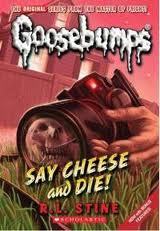
Say Cheese and Die! happens in a town just like anyone’s town, a town called Pitts Landing, the sort of town where they say Pitts Landing is the Pitts, and the sort of town where I say there is no there there. You have been to this town, even if it had a different name when you went there. Greg is friends with Shari and also Michael and also Doug and also Bird, they are all friends with each other, each one a friend with each other one, though in different degrees, but degrees are just small things anyway, they are friends. In a spooky old house Greg and Shari and Michael and also Doug and also Bird find a camera, in the basement they find it and it is not theirs but they make it theirs, even though it is broken. It is broken in a bad way, in a very bad way, in a terrible and evil way, since every picture shows a terrible future, and the children are scared, especially Greg, he does not want his friends to get hurt, what friend would want a friend to get hurt, and this is only the the beginning, as they say, and they do say, it gets worse. Oh, it gets worse. I want to tell you and I do not want to tell you about how much worse. I will not tell you. I have decided. But I will tell you that I am not telling you because I want you to know, I want you to find this book, I want you to read it, I want you to know, and then you will know why I am not telling you.
Now a camera captures a present, makes the present a thing forever, even in the future it makes the present present, the present is here, whenever the picture is seen the present is there, and the past is past, the past is present, the past comes very close, stays very near, the past is here. A camera will do this. Point it at the present and it make it always present, point it at the past make it always past in front of you, make it past in the present, always in the past but always in the present, but then in front of you too, because who could forget that there is the future too, and the camera helps to understand the future because the photos and the past are before you and you look forward, and this makes sense, I have never been afraid of pictures or of cameras either, they are like a friendly dog, an R.L. Stine dog, they make me smile. But with this camera you see a picture and you hate it, you hate hate hate hate hate hate hate hate hate hate hate hate hate it because you are afraid you are very afraid, you are even terrified, because in the photo you are dying, or you are disappearing, or something very evil is happening to someone you love, and now you see why the camera is broken, total junk, evil horrible indestructible junk, oh because it cannot be destroyed, it cannot even be taken back to the store, because it didn’t come from any store at all. It’s a horrifying camera, the very worst camera you can imagine, it makes me wonder about R.L. Stine.
I know that a terrible camera can be a thing, not all cameras are the same. You know I always say a rose is a rose is a rose is a rose, and that is true, it is very true for roses, but for cameras it is not so, no, a camera is not a camera is not a camera is not a camera. It is not so, it is not so, no, it is not so at all not at all. And it follows. Not at all. If you see a evil broken camera in the basement of a spooky house first what are you doing there second leave it alone. Not at all this as follows not at all this as follows not at all this as follow not at all this as follows not at all this as follows not at all, this as follows not at all. This as follows. Required to delight this not at all, this as follows. Very fairly leave it too. Leave it to them leave it to them.
Welcome to 52 Fear Street, McNally Jackson’s month-long celebration of R.L. Stine. Join us on October 30th for an evening with Mr. Stine himself and his Fear Street editor Kat Brzozowski, and follow the #52FearSt tags on tumblr and Twitter to hear what authors, booksellers, and editors have to say about Fear Street and Goosebumps.
Today’s post comes from Dan Poblocki, the author of much fantastic and terrifying writing for young minds. His most recent book is The Book of Bad Things.
One Last Fear Street Party
When I was young, I judged books by their covers.
In fourth or fifth grade, I was drawn to the retro-gothic illustrations of John Bellairs’s spooky mysteries. His stories were filled with ghosts, witches, and evil wizards—highly addictive elements for a kid with a wild imagination and a penchant for scaring his friends with gruesome tales.
Bellairs soon became my favorite author. The frightening parts of his books were based in a reality and time-period that was removed from my own and just fantastical enough for me to sleep soundly.
Over the next few years, growing more desperate to feed my burgeoning horror addiction, I sought out books whose cover images reminded me of Bellairs: houses that looked like they’d come out of the Addams Family comics, or skulls with dark, glaring eye-sockets, or children wandering around in places they obviously shouldn’t be.
When I was eleven, my family moved to New Jersey from Rhode Island, and I entered the nebulous world of middle school. Those things that creeped me out at the age of nine still creeped me out, but in sixth and seventh grade, I discovered a whole new set of things to be worried about—mainly, the social structures and expectations of my new school. For a while, Lois Duncan’s and Joan Lowery Nixon’s thrillers filled a particular need that came with my family’s move. I saw my new world reflected in the tales of teenagers transgressing and paying dearly for their sins. Intense stuff, since the novels were stuffed with components that seemed like they could actually happen in my town.
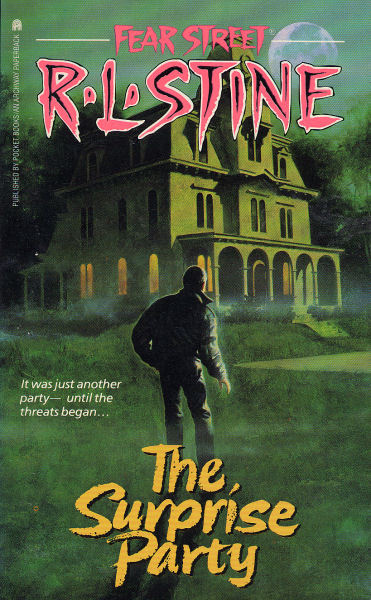
Around this time, I discovered an R. L. Stine book in my school library: The Surprise Party, the second volume in what would become Stine’s epic Fear Street series. Sure enough, it was the cover that caught my eye. On the original paperback, a menacing male silhouette approaches a dark Chaz Addams-style house, a full moon rising over woods in the background. The font was colorful and creepy, and just so hip, in a late 1980’s way. The tagline read: “It was just another party— until the threats began …” I remember thinking, Who is this R. L. Stine? How does he or she know exactly what I want to read?
I devoured The Surprise Party. The wild plot, with its twists and turns and complicated backstory, was like an Agatha Christie mystery blended with the teen slasher movies I loved watching late at night during sleepovers with friends. In Fear Street, the monsters of Bellairs had been replaced with ordinary human killers, and the magic was now made of hormones and jealousy and angst. I knew this kind of magic. I recognized it in myself and my friends every day.
Of course, I wanted more. The books couldn’t come out fast enough. Really, they couldn’t. Of course, now Mr. Stine has an enormous backlist. Actually, enormous isn’t the right word. There is no word for how large his catalogue is. Imagine a time when you’d read all of them, when you had to wait for the next one! Crazy, I know.
In the years since Fear Street debuted, there have been several volumes that have incorporated “party” into the title and/ or story. Halloween Party. All-Night Party. Party Summer. Never mind the stories of prom nights, camping trips, and various other get-togethers. Partying is a teenage theme, but it’s also a Fear Street theme—possibly the Fear Street theme.
For some (okay, let’s be honest, for me), a party can be an event frought with anxiety—about love, about social missteps, about exposure to potential humiliation. When you’re young, a party feels like a rite of passage, and rightly so. You might wake up the next morning and find that you’ve done something you regret or something that feels like it may have changed your life. Fear Street takes these concerns and pushes them through an amplifier filled with blood.
When I learned that R. L. Stine was bringing back Fear Street with a new title, Party Games, I was beyond excited. He’s gone back to his roots! Not only will there be Fear Street for a new generation of horror addicts to discover, but the rest of us who grew up with these books can go back and remember the fun of being terrified by a master of the genre.
And this one’s got a great cover too—a shadowy figure stands atop a steep staircase sprinkled with colorful, yet ominous balloons. Pop! Surprise! An undeniable cause for celebration.
This is the end. My only friend, the end. Or, maybe it’s just an awesome book display at McNally Jackson, New York, NY.
For some reason I just love literature that’s filled with doom and gloom. These books ask questions like: Will the world come to an end? What will happen if it does? In the end, will humans put survival over their own humanity? I haven’t read all these books, but some are right at the top of my list. AndI could ramble on about The Road for hours.
Titles pictured here (from left to right, top to bottom):
Zone One by Colson Whitehead
Star Maker by Olaf Stapledon
The Slynx byTatyana Tolstaya
The Complete Stories of J.G. Ballard
Death from the Skies! by Philip Plait (below)
Oryx and Crake by Margaret Atwood
The Road by Cormac McCarthy
The Children’s Hospital by Chris Adrian
Daughters of the North by Sarah Hall
The Chrysalids by John Wyndham
Living in the End Times by Slavoj Zizek
Cat’s Cradle by Kurt Vonnegut
The Pesthouse by Jim Crace
Post link

